- Home
- James Y. Bartlett
Death in a Green Jacket
Death in a Green Jacket Read online
Contents
Cover
Preface
Prologue
Chapter 1
Chapter 2
Chapter 3
Chapter 4
Chapter 5
Chapter 6
Chapter 7
Chapter 8
Chapter 9
Chapter 10
Chapter 11
Chapter 12
Chapter 13
Chapter 14
Chapter 15
Chapter 16
Chapter 17
Chapter 18
Chapter 19
Chapter 20
Chapter 21
Chapter 22
Chapter 23
Chapter 24
Chapter 25
Chapter 26
Chapter 27
Chapter 28
Chapter 29
Chapter 30
Chapter 31
Chapter 32
About the Author
The Hacker Golf Mysteries
JAMES Y. BARTLETT
Death in a Green Jacket
A HACKER MYSTERY
Copyright © 2010 by James Y. Bartlett
from the Yeoman House Publishers 2004 paperback edition
All rights reserved.
This Yeoman House digital edition of Death in a Green Jacket is an original publication. It is published by arrangement with the author.
This is a work of fiction. All of the events, characters, names and places depicted in this novel are entirely fictitious or are used fictiously. No representation that any statement made in this novel is true or that any incident depicted in this novel actually occurred is intended or should be inferred by the reader.
No part of this book may be used or reproduced in any manner whatsoever without written permission except in the case of brief quotations embodied in critical articles or reviews. For information, address Yeoman House Publishers, 10 Old Bulgarmarsh Road, Tiverton, RI 02878.
Printed in the USA.
ISBN 978-0-9822659-7-0
Library of Congress Control Number: 20044195101
For Susan, as always
Prologue
George Carruthers III, a distinguished banker from Atlanta, was the one who first noticed the foul smell. Carruthers, a high-handicap golfer and longtime member of the Augusta National Golf Club, had managed to hit his golf ball into the large, sweeping bunker that sits some 50 yards in front of the 10th green at the National. That in itself was an accomplishment, though of dubious distinction. That big sweeping bunker is almost never in play during the Masters tournament. When the course was first built in 1932, the bunker had been situated next to what was then the first green. But a few years later, after the nines were reversed, part of the never-ending fiddling that goes on at Augusta National, the green was repositioned up the hill and a bit off to the left.
But they left that big, sprawling bunker right where it was. With its big, upsweeping face, the bunker partially hides the fairway that sweeps uphill to the green, and from some parts of the fairway it looks like it’s protecting the front edge. But it’s all camouflage, which was what the architect of Augusta National, Dr. Alister Mackenzie, had learned about while serving in the British Army during World War I.
Hackers like George Carruthers III do not play the same game as the professionals who visit Augusta every April. He had popped his tee shot high in the air, so it stopped halfway down the great slope of the steep hill that drops away from the clubhouse. Trying to make up his lost distance, despite the unfriendly hanging lie on the side of the hill, Carruthers then tried a fairway wood, which he topped dreadfully, sending it skittering along the fairway until it chased into Dr. Mackenzie’s bunker. Had this been the Masters, the TV announcer might have fallen out of his booth in amazement—no one ever hit a ball into that bunker. But this wasn’t the Masters, there were no announcers, and the members of the hallowed old club are all too familiar with that bunker.
Carruthers cursed, grabbed a nine-iron and sent his caddie on ahead to the green while he climbed down into the bright white sand, littered with bits of pine straw that dropped from the surrounding canyon of loblolly pines. He was thinking that if he could somehow manage to knock his ball up on the green, he had half a chance to make bogey. For golfers like George Carruthers III, bogey is always something to celebrate at Augusta National.
But as he entered the expanse of sand, he immediately noticed the smell. It was the smell of death. Sickly sweet, the odor of decay, it announced that something was dead and decomposing in the warm Georgia sun. Nose wrinkling with distaste, the fastidiously groomed Atlanta banker looked around for the tracks of an animal he was certain had died somewhere in the vicinity of his golf ball. But the bunker was empty, immaculately swept, the sand virtually undisturbed. Around the edges of the bunker, the grass had been neatly trimmed and carefully edged, as if Carruthers’ own barber, whose shop he visited in the basement of the Candler Building once every two weeks, had gone around the entire bunker with his clippers, combing and trimming so that every blade of grass was in its prescribed place.
Shrugging, Carruthers stepped up to his ball, swung, and bladed it neatly over the green and down the grassy bank beyond. When he trudged up to the green, his playing partners chided him humorously. He could only shake his head.
“Phew,” he said. “Something is dead down there. How can I play a tough shot with that smell?”
“The only thing that stinks around here,” said one of the wags in his foursome, “Is your golf swing.”
Carruthers and company played on, and, as they chopped their way around the rest of Augusta National’s fabled back nine, the incident was soon forgotten. Several hours later, as Carruthers and his friends sat in the members’ lounge, enjoying a cold beer, Augusta’s head golf professional, Martin Tynsdale, walked by and asked the gentlemen how their round had fared.
“We stunk the place up,” said one, looking at the scorecard in disgust.
“That reminds me, Marty,” Carruthers piped up. “I smelled something dead in the front bunker on 10. You might have one of the fellows check it out. Most unpleasant.”
“Yes, sir, Mr. Carruthers,” Tynsdale said. “We’ll get right on that. Was that the bunker to the right of the green?”
The table laughed, all except Carruthers. “No, Marty,” he said, his face turning red. “The front one. Down the fairway.”
Tynsdale smiled knowingly and gave George Carruthers III a friendly squeeze of the shoulder. “Thanks,” he said, “I’ll have someone go down and look around.”
It was an hour before sunrise the next morning when Bill Beckham, the course superintendent, motioned to Chas Johnson. Johnson was getting ready to drive out onto the course to mow the greens on the back side. He and two other workers had already been up for an hour, mowing the front side greens in the chill darkness with the bright headlamps as their guide.
“Chas,” Beckham said. “Marty called yesterday afternoon and said one of the members complained about something dead and smelly down in the front bunker at 10. Check it out, will you? Must be a squirrel or something that a hawk left behind. And check all around the area—smells are funny. They can drift in from anywhere.”
“Yessah,” Johnson said, getting up into the seat of his triplex mower. It was the newest model and it looked as clean and shiny as they day it had rolled out of the factory. Nothing at Augusta National ever looked worn or used. What Johnson didn’t say, but was thinking, was “Goddam members prolly think their own shit smells better than anyone else.”
Johnson had to drive a
circuitous passage down to the tenth green—machinery was to be kept off the fairways at all times. There were secret pathways and openings through the woods that the grounds crew knew to use, so it took Chas several minutes before he pulled up next to the green. Dismounting, he walked back the 50 yards or so to the Mackenzie bunker, its yawning expanse glimmering the in the dawn light.
He smelled it, too. It was obvious, overpowering. Chas Johnson, who had served with the Marines in Viet Nam, was familiar with the smell of death. Something near this bunker was very, very dead. Pulling his jacket collar around in front of his nose and mouth to filter out the nauseating stench, Johnson walked around the perimeter of the bunker, looking for something out of place. There was a set of animal tracks in the soft white sand, but he could see where the critter had entered, dug a little, and where it had left. Nothing else seemed out of place. He walked back up to the green, and examined the bunker to the right, the place where pros often bailed out on Sunday afternoon to avoid the certain bogey of a pulled shot down the bank to the left. The odor of death lingered here, too, but again, nothing seemed out of place.
Johnson walked back down the hill to the high lip at the upsweep of the bunker. He stared at the sand with the practiced eyes of someone who had worked on this golf course for nearly 30 years.
There! To the right, where a finger of green turf probed into the white sand, providing both a curvilinear design on the bunker’s edge and a place for golfers to enter and exit the sand. Just where the green finger ended, Chas Johnson thought that the surface of the sand looked slightly convex, slightly bulged. Not perfect, and therefore not normal.
Looking around, he found a bunker rake and walked around and back down into the sand. To his practiced feet, the sand felt slightly harder than it should. He took the rake and began gently digging into the white silica. The sand, which should have been silky and loose, seemed hard and packed. Something wasn’t right. He kept digging and moving sand back with the rake.
Suddenly, one of the tines caught on something. Chas Johnson pulled. The rake was caught. He pulled harder. Slowly, whatever his rake had snagged out began to pull free from the sand. Then it came up out of the sand and into sight.
Chas Johnson stared with wordless horror as he pulled a human arm out of the sand. The rake had caught beneath the band of a wristwatch. The arm, grey and green in the dawn light, was still connected to a torso buried deeper in the sand. But Chas Johnson wanted nothing more to do with his grisly job. He dropped the rake, ran back to the green, jumped into his mower and, ignoring all the rules about keeping off the fairway, blasted back up the hill towards the clubhouse as fast as his mower could go.
The fingers of the hand, which had fallen back onto the sand, next to the rake that Chas dropped, pointed towards the green.
Chapter One
We were in Ponte Vedra Beach, getting ready for the Players Championship, when the story came across the wires about the body found in the bunker at Augusta National. “We,” of course, are the traveling band of brothers known as golf writers who follow the Tour around the country for the benefit of our readers back home, the members of Hacker Nation. In my case, that’s literally true. “Hacker on Tour” in the Boston Journal. Catchy, huh? Blame that barely functioning idiot known as my editor.
It was Tuesday morning, and the field of most of the world’s best players were out on Pete Dye’s golf course trying to figure out how to golf their balls around the course without running afoul of the acres of sandy “waste area” and the oceans of gator-filled water hazards or, perhaps more importantly, how to get their approach shots to find those sections of the greens that are not on the wrong side of the buried elephants Dye installed beneath the gentle green turf of the Stadium course.
The press room at The Players is both large and luxurious—the tournament is the marquee event for the PGA Tour, played at their headquarters, and they really roll out the red carpet for the press during the week. Because this tournament is one of a dwindling few that manages to attract most of the top players in the world to the same place at the same time, the press contingent—both domestic and international—is quite large. Most of the British golf press come over for the Players, then head for the nearest beach to burn themselves lobster red before they make their way up to Augusta. So the PGA Tour built a state-of-the-art press room, with electronic scoreboards, Wifi connections for our laptops, hot buffet lunches every day, a regular procession of players trotted in and out of the interview area to provide those sound bites upon which we all have come to depend, and a large staff of attractive helpers ready to hasten to do our bidding, should we have any needs.
Well, journalistic needs, anyway. But on this Tuesday morning, the cavernous press room was less than half full, as many writers were themselves out sampling some of the Jacksonville area’s finest golf courses. Normally, I would have been out there too, getting in eighteen up at Amelia Island, or out at The Ravines, or even along the beach at the old Ponte Vedra Inn. But I actually had a little catch-up work to do. Last weekend, the Tour had been over in Orlando, at Arnold Palmer’s Bay Hill, and Mary Jane Cappaletti and her precocious young daughter Victoria had flown down for the weekend to “do the parks.” Mary Jane lives in the apartment below mine in Boston’s North End, and we had not that long ago embarked upon that journey known as “a relationship.” It had actually been nice having them around, taking them out to some of the millions of family and theme restaurants in O-town and listening to their excited jabbering about the rides they had been on and the things they had done while I was at the golf course, watching Ernie Els smooth his way around Arnie’s tough course for a win. They had an early-afternoon flight home on Monday, so we slept in, and then had a nice breakfast. I had driven them over to the Orlando airport, hugged and kissed them both goodbye, and headed up the interstate for the Atlantic coast and Jacksonville.
So when the news from Augusta crossed the wires late that morning, there weren’t too many of us around to discuss all the ramifications. The facts were pretty sparse anyway. The Augusta police reported that the body of one John H. Judge, aged 26, had been discovered Monday morning buried in a bunker on the tenth hole of the famed Augusta National Golf Club. Judge was a resident of Grovetown, Georgia, located outside Augusta near the U.S. Army base at Fort Gordon, and an accountant for the local office of BellSouth. He was not a member of the club, no one there seemed to know him at all, and no one had any idea who had killed the man or why he had been buried in a bunker. Investigation continues, autopsy scheduled, etc. etc. etc.
John “Quigs” Quigley from the Detroit News was sitting a few desks from me.
“Body in the bunker?” he said, speaking mostly to himself, his reading glasses pushed up atop his mostly bald head as he scanned the news sheet that had just been handed out to all of us. “Isn’t that the name of a novel by Agatha Christie?”
“I think her book is ‘The Murder on the Links,’” I said.
“Yeah, it’s a little too trite for the Dame,” he said. He scratched the side of his nose thoughtfully. “Whaddya think, Hacker?” he asked me. “Why would someone bury someone they just killed in a sand trap at Augusta National three weeks before the Masters? You’d have to be nuts.”
“Whereas if you killed someone and just dumped the body in the Savannah River, you’d be sane,” I said.
He chuckled. “Point taken.”
“But you’re probably right,” I said. “Whoever did this wanted the body to be found. That’s why he stuck it in one of the most public private places in Augusta, if not the entire country.”
Quigs looked at me sideways.
“You know Hacker,” he said. “You keep getting involved in all these murders and stuff, people are gonna talk. Or at the least, not want to hang out with you.”
“I didn’t do it!” I protested, laughing. “I just made an observation.”
We started talking about the NCAA basketball tournament that was
beginning to heat up, and swapped a few baseball tidbits from spring training, and soon forgot all about the body in the bunker at Augusta National.
But there was still a piece of gray matter in the back of my head that was turning things over, poking at them, trying to understand. Who was this John Judge and why did he have an enemy who wanted him dead? Where had he been killed? Why had he been planted in the sand on the tenth hole? And how come none of Augusta’s vaunted Pinkerton guards saw anything?
Quigs eventually went back to his laptop and I stared off into space. Finally, I shook my head and decided to get back to work. There were plenty of questions, but none of them were my business. I had a bunch of quotes and notes to put together for the morning paper and it was up to the Augusta police to ask all the questions about John H. Judge, age 26, deceased.
Besides, if I got my stuff done, I might still make an afternoon tee time to get in a quick nine.
Chapter Two
On Sunday night, after Tiger Woods had rolled to another impressive victory at The Players, pretending to let Phil Mickelson and Vijay Singh have a sniff at the lead before going out on that afternoon and throwing a nifty little 65 at them, leaving all of us with no choice but to install him as the prohibitive favorite heading into Augusta National in three weeks’ time—hell, he would have been the prohibitive favorite at the Masters if he had shot a 79 and broken his leg along the way—I sat back in the slowly emptying press room and tried to decide what to do with a free week.
The Tour was moving on to Atlanta, but most of the best players were going home for a week to practice, consult with their swing and mental gurus and generally get their game faces on for the first major of the year. The field left for the TPC at Sugarloaf was ho-hum at best. A bunch of the golf writers were heading up the coast to Myrtle Beach, South Carolina and the annual golf writers’ golf tournament, a weekend of fun, booze and bad golf. I hadn’t signed up for the tournament, because I’m getting too old for the boozing nightlife, my golf game was nonexistent and I pretty much hate Myrtle Beach, which has turned into a 70-mile-long traffic bottleneck filled with franchised restaurants, putt-putt emporiums, red-neck attractions and too many bad golf courses to count. Other than that, I’m sure it’s swell.

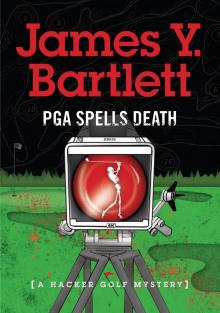 P.G.A. Spells Death
P.G.A. Spells Death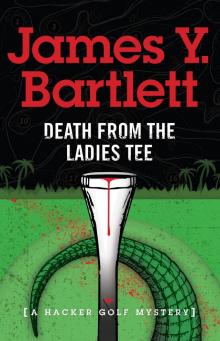 Death from the Ladies Tee
Death from the Ladies Tee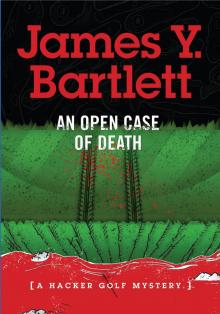 An Open Case of Death
An Open Case of Death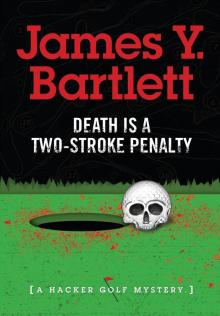 Death is a Two-Stroke Penalty
Death is a Two-Stroke Penalty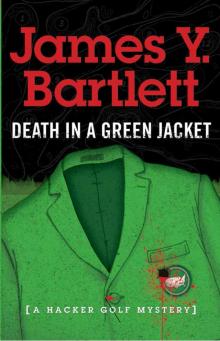 Death in a Green Jacket
Death in a Green Jacket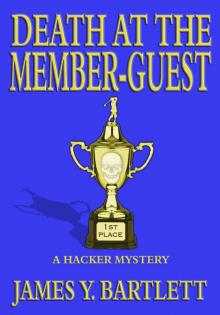 Death at the Member Guest
Death at the Member Guest